
The pipe organ is a musical instrument that produces sound by driving pressurised air through the organ pipes selected from a keyboard. Because each pipe produces a single pitch, the pipes are provided in sets called ranks, each of which has a common timbre, volume, and construction throughout the keyboard compass. Most organs have many ranks of pipes of differing pitch, timbre, and volume that the player can employ singly or in combination through the use of controls called stops.
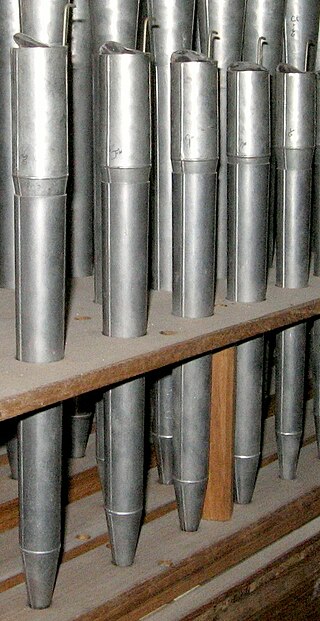
The vox humana is a short-resonator reed stop on the pipe organ, so named because of its supposed resemblance to the human voice. As a rule, the stop is used with a tremulant, which undulates the wind supply, causing a vibrato effect. The vox humana is intended to evoke the impression of a singing choir or soloist, though the success of this intent depends as much upon the acoustics of the room in which the organ speaks as it does the voicing of the pipes. It is almost invariably at 8 ft pitch, though on theater organs it is not uncommon to encounter a chorus of vox humana stops unified at 16 ft, 8 ft and occasionally 4 ft pitch on the Great manual and 8 ft and 4 ft pitch on the Accompaniment manual.

An organ stop is a component of a pipe organ that admits pressurized air to a set of organ pipes. Its name comes from the fact that stops can be used selectively by the organist; each can be "on", or "off".

Ostheim vor der Rhön is a town in Northern Bavaria in the district of Rhön-Grabfeld in Franconia. Though politically part of Bavaria since 1947, it was historically a part of Thuringia, and remains religiously, architecturally, and to some extent culturally distinct from its immediate surroundings.

A flue pipe is an organ pipe that produces sound through the vibration of air molecules, in the same manner as a recorder or a whistle, in a pipe organ. Air under pressure is driven through a flue and against a sharp lip called a labium, causing the column of air in the pipe to resonate at a frequency determined by the pipe length. Thus, there are no moving parts in a flue pipe. This is in contrast to reed pipes, whose sound is driven by beating reeds, as in a clarinet.
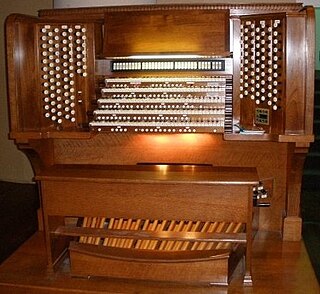
The symphonic organ is a style of pipe organ that flourished during the first three decades of the 20th century in town halls and other secular public venues, particularly in the United States and the United Kingdom. It has roots in 19th-century Europe, and is a variation of the classical pipe organ. It features expanded capabilities, with many pipes imitative of orchestral instruments, and with multiple expressive divisions and organ console controls for seamlessly adjusting volume and tone, generally with electric organ actions and winding. These expansions let the organist approximate a conductor's power to shape the tonal textures of Romantic music and orchestral transcriptions. These organs are generally concert instruments as opposed to church organs. The symphonic organ has seen a revival in the US, Europe and Japan, particularly since the 1980s.
Ophicleide and Contra Ophicleide are powerful pipe organ reed pipes used as organ stops. The name comes from the early brass instrument, the ophicleide, forerunner of the euphonium.

The Boardwalk Hall Auditorium Organ, also known as the Midmer-Losh and the Poseidon, is the pipe organ in the Main Auditorium of the landmark Boardwalk Hall in Atlantic City, New Jersey. The musically versatile instrument was built by the Midmer-Losh Organ Company during 1929–1932. It is the largest organ in the world, as measured by the number of pipes – officially 33,112, but the exact number is uncertain. After decades of accumulated damage from water, building renovations, neglect, and insufficient funding, now a multi-million-dollar restoration program is gradually returning the organ to full operability.
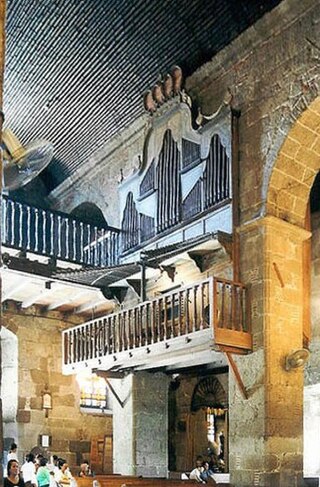
The Las Piñas Bamboo Organ in St. Joseph Parish Church in Las Piñas, Philippines, is a 19th-century church organ. It is known for its unique organ pipes; of its 1031 pipes, 902 are made of bamboo. It was completed after 6 years of work in 1824 by Father Diego Cera, the builder of the town's stone church and its first resident Catholic parish priest.
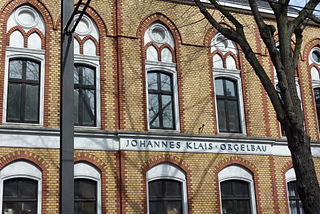
Orgelbau Klais is a German firm that designs, builds and restores pipe organs. It is a family run company, founded in 1882 by Johannes Klais senior and is now run by his great-grandson Philipp Klais. The firm is based in Bonn, Germany, and has completed many large-scale building and restoration projects around the globe in more than a century of organ building.
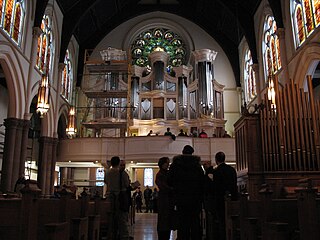
EROI or the Eastman Rochester Organ Initiative is a project run by the Eastman School of Music with the goal of creating a unique collection of organ instruments in Rochester, New York.
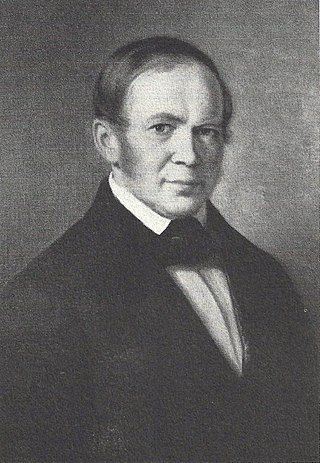
Walcker Orgelbau of Ludwigsburg, Baden-Württemberg, Germany, is a builder of pipe organs. It was founded in Cannstatt, a suburb of Stuttgart in 1780 by Johann Eberhard Walcker. His son Eberhard Friedrich Walcker moved the business to Ludwigsburg in 1820.

Expo 2012 was an International Exposition recognized by the Bureau International des Expositions (BIE) held in Yeosu, South Korea which opened on May 12, 2012 and ran until August 12, 2012. The theme of the Expo was "The Living Ocean and Coast" with subthemes of "Preservation and Sustainable Development of the Ocean and Coast", "New Resources Technology", and "Creative Marine Activities". There were 105 participating countries, international organizations, and 8,203,956 visitors.

Jürgen Ahrend was a German organ builder famous for restoring instruments such as the Gothic Rysum organ and the Arp Schnitger organs of the Martinikerk in Groningen, Netherlands, and of St. Jacobi in Hamburg as well as building original instruments. He ran the workshop Jürgen Ahrend Orgelbau in Leer from 1972 to 2004, operating internationally.

The organ of Poblet is a three manual, 56 stop pipe organ installed in the church of the Abbey of Santa Maria of Poblet. It was built in 2012 by the Swiss firm Metzler Orgelbau AG.

Xaver Wilhelmy is an inventor, designer and certified pipe organ builder who was the first in the world to create organ pipes from glass. Wilhelmy created the Wilhelmy American Flag Glass Pipe Organ, the first pipe organ in the world with pipes made entirely from glass.

Orgelbau Pieringer is an Austrian organ building company based in the city of Haag in Lower Austria. The founder and owner of the company is the Haag organ builder Johann Pieringer. Orgelbau Pieringer is a reputable organ workshop active for 25 years throughout Austria, Germany and Croatia, as well as a member of International Society of Organbuilders.

Wolf Bergelt is a German author, organist and organ scholar.
















